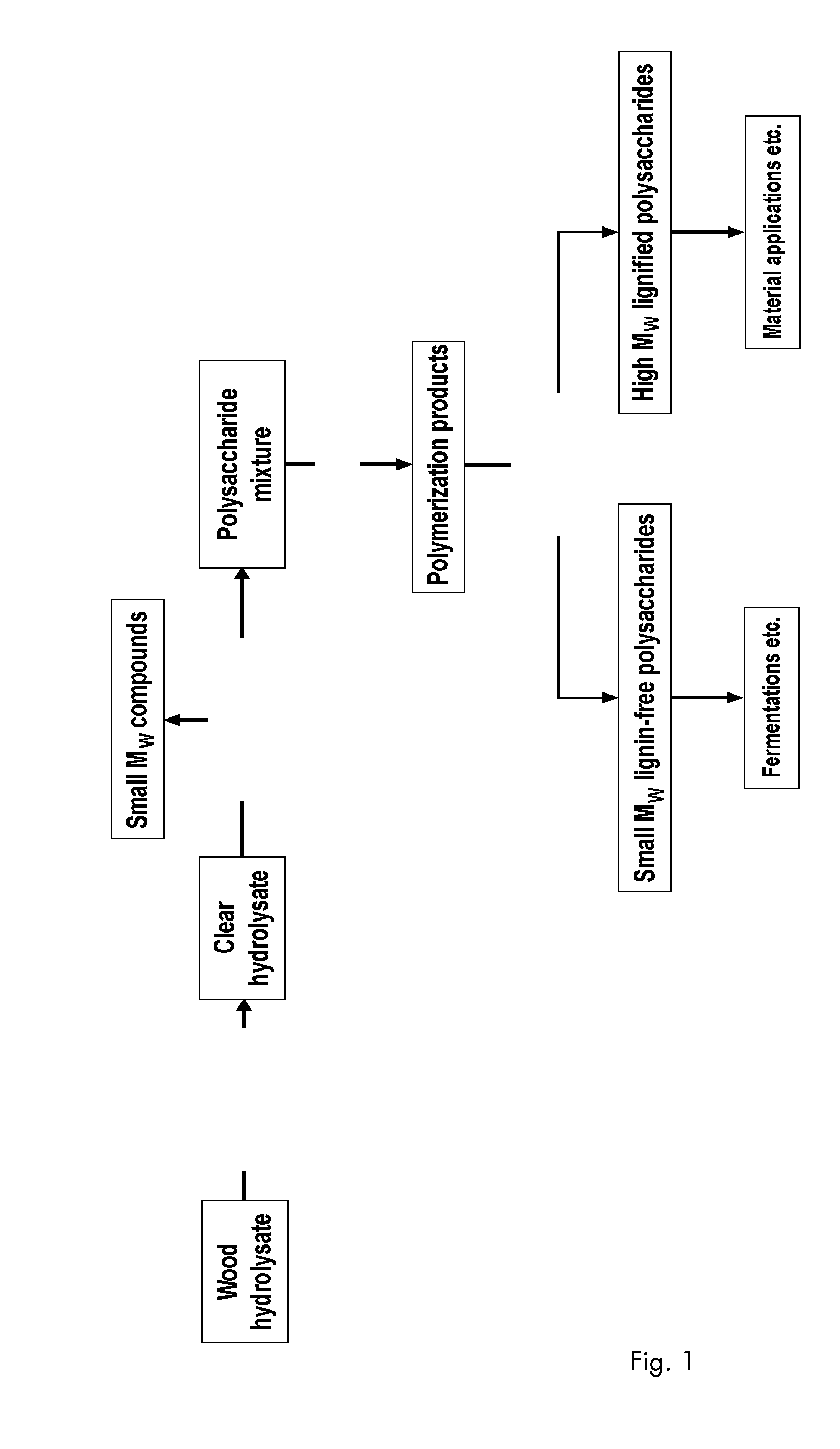Method to increase the molecular weight of wood mannans and xylans comprising aromatic moieties
a technology of aromatic moieties and mannans, which is applied in the field of crosslinking and processing of wood mannans and xylans, can solve the problems of significant reduction of the carbon footprint of these industries, high cost of building such purification plants, significant problems in fractionation, upgrading and the use of molecules, etc., and achieves easy and cost-effective isolation, wide application areas, and easy and cost-effective effects
- Summary
- Abstract
- Description
- Claims
- Application Information
AI Technical Summary
Benefits of technology
Problems solved by technology
Method used
Image
Examples
example 1
Extraction of Hemicelluloses from Industrial Norway Spruce Chips
[0087]Four 250 g batches of dried industrial chips, obtained from spruce (Picea abies) with a dry content of 95% and screened on a laboratory screen passing 8 mm but not 2 mm, was charged to batch autoclaves with 2 l of de-ionized water each. The mixture was processed at 160° C. for 60 min after which the wood chips were separated from the hydrolyzate on a paper machine filter (Monodur PA 71 μm, Derma AB). Each batch of chips was washed with 500 ml of boiling de-ionized water. The liquid fractions were combined, giving a total volume of 8.2 l. The hydrolyzate was further filtrated by micro filtration in a pilot scale ultrafiltration machine (Mini kerasep module, Novasep) with a ceramic membrane (The kerasep 0.45 μm, Novasep). Two liters of de-ionized water was added at the end of the filtration giving a 9 liter final volume of permeate (sample SCHW). The total yield of wood substances isolated with the hydrolyzate corre...
example 2
Upgrading of the Spruce Chip Hydrolyzate by Ultrafiltration
[0088]The hydrolyzate (SCHW) was upgraded by fractionation using ultrafiltration (Mini kerasep module, Novasep) employing a ceramic membrane with a cut-off of 1 kDa (The kerasep 1 kDa, Novasep). This was done to filter away the small molecular weight substances from the sample. The membrane filtration was performed to concentrate the retentate (the high molecular weight fraction) down to a volume of 2 l and thus giving 7 l permeate (the low molecular weight fraction). The high molecular weight fraction was further purified by diluting it with de-ionised water to 9 l and then again membrane filtering down to a volume of 2 l. The yield of high molecular weight materials thus obtained from the wood hydrolyzates by membrane filtration was 52% based on dry weight of the hydrolyzate. The sample is abbreviated as SCHW UF1.
example 3
Polymerization of the Sample SCHW UF1
[0089]Upgraded hydrolyzate (sample, SCHW UF1) was treated with laccase-enzyme (NS51002, Novozymes Bagsvaerd, Denmark) under the following conditions: Enzyme dosage 14 U / g of hydrolyzate, hydrolyzate concentration 100 mg / ml, pH 5.0, temperature +40° C., reaction time 3 hours during which time pure oxygen gas was introduced to the sample. The treatment with these conditions gave the sample (SCHW UF1 P).
PUM
| Property | Measurement | Unit |
|---|---|---|
| molecular weight | aaaaa | aaaaa |
| temperature | aaaaa | aaaaa |
| molecular weight | aaaaa | aaaaa |
Abstract
Description
Claims
Application Information
 Login to View More
Login to View More - R&D
- Intellectual Property
- Life Sciences
- Materials
- Tech Scout
- Unparalleled Data Quality
- Higher Quality Content
- 60% Fewer Hallucinations
Browse by: Latest US Patents, China's latest patents, Technical Efficacy Thesaurus, Application Domain, Technology Topic, Popular Technical Reports.
© 2025 PatSnap. All rights reserved.Legal|Privacy policy|Modern Slavery Act Transparency Statement|Sitemap|About US| Contact US: help@patsnap.com


